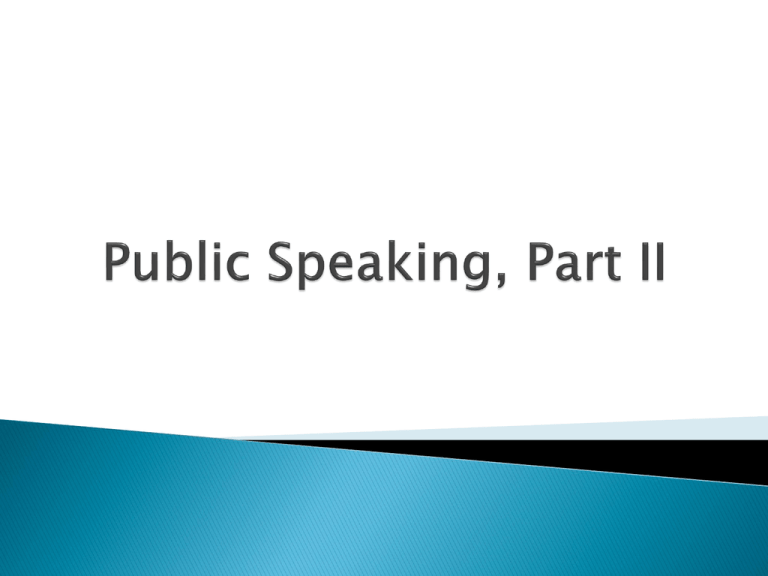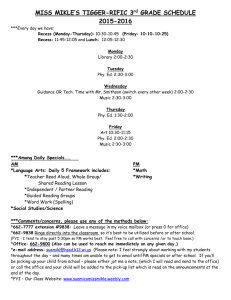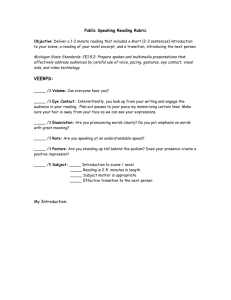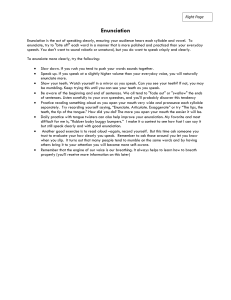Document 15960903
advertisement

Introduction ◦ Spark the interest of your audience Organized, well-thought out body ◦ Make sure the speech is organized in some logical way that the audience will be able to follow. Clear conclusion ◦ Review your main points and signal to your audience that the speech is coming to an end. Appearance ◦ Don’t fidget. ◦ Don’t rock or sway. ◦ Keep your hands away from your face and hair. ◦ Don’t lean on the podium if you choose to use it. Volume ◦ Your voice must reach the back of the room. ◦ Remember that when you look down, your volume drops. ◦ Never hold notes in front of your face. It blocks the sound waves and detracts from your volume. ◦ Understand that you need to speak at a louder volume in a formal speech situation than you would in a personal conversation. Inflection ◦ Your voice should be expressive, but not singsongy. ◦ Aim for something slightly more formal than conversational speech patterns. ◦ Sentences go down in pitch at the end, but don’t let your voice go so far down that you drop off the last word. Enunciation (clarity) ◦ Slowing down will improve enunciation. ◦ Speaking in public is different than personal conversation. Public speaking requires that you clearly pronounce each individual word. ◦ It may sound unnaturally precise to your ears, but your audience will thank you! Pronunciation ◦ If you are unsure how to pronounce a word, look it up in the dictionary or ask someone. ◦ If you continually stumble over a particular word, pick a different word! Make sure you are using correct grammar! If you have a question about proper grammar, ask! Use vocabulary appropriate to your audience. If you use an uncommon, technical word that your audience would not know, explain it. Use transition words to move from point to point. Examples of transitions are the first thing, next, finally, however. YOU ARE ALREADY EXPERIENCED PUBLIC SPEAKERS. AVOID THE “IN CONCLUSION” CONCLUSION!!! Eye Contact!!!! ◦ This is imperative! Make your audience feel like you are including them in your presentation. ◦ If you are nervous, look above the audience’s head. ◦ Do not read from your notes! They are there only to help you get from one point to the next. You should only have to glance at them while speaking. Your pace should be brisk enough to keep us interested, but slow enough that we aren’t struggling to discern what you are saying. Your delivery should be smooth. There should not be any long pauses or stumbling once you begin speaking. The best way to improve smoothness is to practice out loud often. No distracting gestures. These include tucking your hair behind your ear, tapping your fingers or toes, fussing with your clothing. Anything that you do that we notice over and over distracts us from what you are saying. No vocalized pauses. Try to clean up all the ums, uhs, likes and so forth from your speech. Some speeches may require a visual aid. Make it interesting! The only way you are going to fit within the time constraints is to practice and continually tweak your work until it is just perfect! As always, a 15 second buffer in either direction will apply. Have fun! Fairy Tale 2:00-2:30 Personal Experience 2:00-2:30 Job/College 2:30-3:00 Informational 2:30-3:00 Power Point 3:00-5:00


